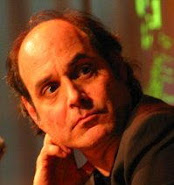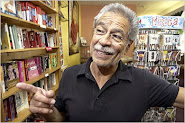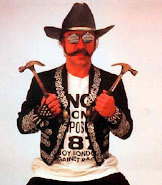 Hugo Morales
Hugo MoralesIntroduction
This lesson was developed as part of the Discovering the Genius in You curriculum which is based on the MacArthur Latino Fellows Bios and the http://www.sandracisneros.com/macarturos_schedule_2007.php.
Students will have the opportunity to explore contributions made to U.S. society by Latinos by visiting websites. They will be asked to look for specific Latinos who have been recipients of awards granted by the MacArthur Foundation.
Content Area and Grade Level
This lesson is designed for grades 6-8. Its focus is on contributions of Latinos to historical or contemporary societies, which is appropriate for the 6-8 grade curriculums in the state of Texas.
Curriculum Standards
Outcomes:
Students will:
1. Identify Latino Geniuses using the 5Ws: who, what, when, where, and why?
2. Make a timeline that shows the contributions they have made in our community/society.
3. Design a poster/PowerPoint to inform the community and increase the public's awareness about the contributions of Latinos to society.
4. Do a presentation explaining the significance, achievements and influence of individuals on society to the class.
§113.22. Social Studies, Grade 6.
2) History. The student understands the contributions of individuals and groups from various cultures to selected historical and contemporary societies. The student is expected to:
(A) explain the significance of individuals or groups from selected societies, past and present; and
(B) describe the influence of individual and group achievement on selected historical or contemporary societies.
22) Social studies skills. The student communicates in written, oral, and visual forms. The student is expected to:
(A) use social studies terminology correctly;
(B) use standard grammar, spelling, sentence structure, and punctuation;
(C) transfer information from one medium to another, including written to visual and statistical to written or visual, using computer software as appropriate; and
(D) create written, oral, and visual presentations of social studies information.
§113.23. Social Studies, Grade 7
22) Social studies skills. The student communicates in written, oral, and visual forms. The student is expected to:
(A) use social studies terminology correctly;
(B) incorporate main and supporting ideas in verbal and written communication;
(C) express ideas orally based on research and experiences;
(D) create written and visual material such as journal entries, reports, graphic organizers, outlines, and bibliographies; and
(E) use standard grammar, spelling, sentence structure, and punctuation.
§113.24. Social Studies, Grade 8
(31) Social studies skills. The student communicates in written, oral, and visual forms. The student is expected to:
(A) use social studies terminology correctly;
(B) use standard grammar, spelling, sentence structure, and punctuation;
(C) transfer information from one medium to another, including written to visual and statistical to written or visual, using computer software as appropriate; and
(D) create written, oral, and visual presentations of social studies information.
Technology Embedded:
1. BASIC OPERATIONS AND CONCEPTS:
Students demonstrate an understanding of operation of technology systems.
2. TECHNOLOGY PRODUCTIVITY TOOLS:
Students use technology tools to enhance learning, increase productivity, and promote creativity.
Students use a variety of media and formats to communicate information and ideas effectively to multiple audiences.
Students use technology to locate, analyze, and collect information from a variety of sources.
Procedures:
"Getting to Know a Latino/a Genius!" has been designed for the classroom/library/computer lab setting, where a whole class can work on it at once or student pairs can work together as a computer/library assignment. The lesson is organized so that a pair of students can follow the directions listed below at the computer to complete 11 tasks. Ideally, this project will take about ten, 45-minute lab periods. Here is a sample of how it might go:
Day One
Task 1: As a whole group in the classroom, we will brainstorm what we know and what we would like to learn on a K-W-H-L Chart about Latino/a Geniuses.
Download the K-W-H-L Chart template:
http://www.education-world.com/tools_templates/kwhl_nov2002.doc
Task 2: We will be introduced to the Mission Statement of "Los MacArturos" and provide an overview of the MacArthur Foundation.
Task 3: As a whole class, we will begin exploring the reasons why Hugo Morales is known as a Latino Genius and complete the 5Ws Template to plan and organize the straight news article.
Download a 5 Ws Template
As a large group visit internet sites to read and gather information about Hugo Morales and respond to the 5Ws Template and discuss his contributions to society.
Task 4: Discuss Hugo Morales’ achievements and influence in society. Also discuss the reasons he was selected as a MacArthur Foundation Fellow. Create a Timeline using biographical information found in the following internet sites:
http://www.hablamosjuntos.org/signage/signage_oversight/pac.asp
http://www.radiobilingue.org/archive/03_03_14_hugomorales.htm
http://www.cpb.org/pressroom/release.php?prn=146
http://www.cpec.ca.gov/Commission/MemberPage.ASP?CM=35
http://www.current.org/people/peop909morales.html
http://www.lannan.org/lf/bios/detail/hugo-morales/
Task 5: Choose a partner and select a Latino/a` Genius to investigate. The next week you will be working with your partner to do the following on the person you have selected:
1) complete a 5Ws Chart Download a 5 Ws Template
2) create a Timeline
Download the Timeline template:
http://pesd.alevelhigher.com/technology_and_learning/on-line_learning/pdfs/creating_timelines_from_templates.pdf
3) design a poster/PowerPoint
4) present to class the news story
Days Two thru Five
Task 6: Visit Internet sites (listed below) and take notes on each. Complete 5Ws Chart and create timeline.On the third day, ask the students to complete a "Day Three Self-Evaluation."
Days Six and Seven
Task 7: Discussion with another group of students. Use PowerPoint to display findings or concept maps (e.g. Pictures, 5Ws Charts, and Timelines) which shows the contributions made to society by the Latino Geniuses each group is investigating.
Task 8: Class discussion.See 5Ws Charts and Timelines from class discussions
Task 9: Choose an important idea or tip to increase the public's awareness about Latino’s contributions. Make a poster that will be hung in your community.
Days Nine and Ten
Task 10: Complete a self-evaluation rubric.
Task 11: Share work in 3-5 minute presentations.
Resources Needed
Technology stuff you'll need:
At least 2 computers (one with Internet access)
Microsoft Word, or any type of word processing program
PowerPoint Software
Websites your students will access:
http://www.hablamosjuntos.org/signage/signage_oversight/pac.asp
http://www.radiobilingue.org/archive/03_03_14_hugomorales.htm
http://www.cpb.org/pressroom/release.php?prn=146
http://www.cpec.ca.gov/Commission/MemberPage.ASP?CM=35
http://www.current.org/people/peop909morales.html
http://www.lannan.org/lf/bios/detail/hugo-morales/
Human resources you might consider:
A guest speaker Latino Genius or another Latino Leader from the community for more information.
An aide or parent helper to guide the students and help out with any computer glitches
On-line teacher support for other ideas and support .
Entry Level Skills and Knowledge
Technology stuff your students (and you) will need to know:
How to navigate on the Internet: links, URLs, bookmarks, going back and forth
How to open and save files
How to use word processor to create Timeline
How to use PowerPoint to create concept maps (brainstorms) and presentations
Evaluation
Before students begin any of the 11tasks, they should be provided with a rubric on what they will be evaluated. At the end of the lesson, students will complete an evaluation for themselves, and one for their partner. Click: http://rubistar.4teachers.org/ to customize a rubric for this lesson.
Students could be evaluated in five areas: Participation, Brainstorm and Notes, Concept Maps (5Ws Chart and Timeline), Poster, and Presentation.
The teacher will review the students self evaluations and make changes or additions as necessary.
Introduce this project by asking students to name and share stories of Latinos leaders in the community, city, state, country, or countries from where students or their parents have immigrated.
Read literature about Latinos who have made an impact in United States societies.
Get involved. Send letters (snail-mail or e-mail) to public school libraries and local public librarians to add more books, journals, and videos related to Latinos to the library collection.
Conclusion
Through this lesson students will discover more about Latinos in the United States. Encourage them to share what they learn with others to increase the awareness about the contributions that this group has made in U.S. Society.
Last updated on September 29, 2007
by Lorena Claeys, University of Texas at San Antonio
If there are any questions, comments, or recommendations,feel free to e-mail me.Just click on my name above.
References
This lesson was based on a template from http://www.instantprojects.org/
The following electronic resources were accessed to gather information to create this lesson plan:
http://www.tea.state.tx.us/rules/tac/chapter113/ch113b.html Chapter 113. Texas Essential Knowledge and Skills for Social StudiesSubchapter B. Middle School
http://www.sandracisneros.com/macarturos_schedule_2007.php MacArturos 2007 Reunion
http://www.sandracisneros.com/macarturos_bios.php MacArturos Biographies
http://www.sandracisneros.com/macarturos.php MacArturos Mission Statement
http://www-tc.pbs.org/newshour/extra/teachers/lessonplans/socialstudies/Vote2004/news_h5.pdf 5Ws Template
http://pesd.alevelhigher.com/technology_and_learning/on-line_learning/pdfs/creating_timelines_from_templates.pdf
Timelines Microsoft Template
http://www.hablamosjuntos.org/signage/signage_oversight/pac.asp Advisory Committee Bios
http://www.radiobilingue.org/archive/03_03_14_hugomorales.htm Hugo Morales is the Executive Director of Radio Bilingüe, Inc. In 1976, Mr. Morales and an all-volunteer staff of farmworkers, former farmworkers, and artists founded Radio Bilingüe, which began radio broadcast operation on July 4, 1980 over the entire San Joaquin Valley.
http://www.cpec.ca.gov/Commission/MemberPage.ASP?CM=35 Hugo Morales was appointed to the California Postsecondary Education Commission by the Senate Rules Committee on June 11, 2003, to represent the general public.






No comments:
Post a Comment